5.13 Mendelian Inheritance
Created by: CK-12/Adapted by Christine Miller

Albinism
This child has much lighter skin and hair than his parents. He has a condition called albinism, which results from a lack of the pigment melanin in the skin, hair, and eyes. Although he looks different than his parents, albinism is actually a genetic trait. Genetic traits are characteristics that are encoded in DNA. Most forms of albinism are recessive, which is why the child’s parents were able to pass the trait to him without exhibiting the condition themselves. You will learn more about this type of inheritance in this concept. Albinism is one of the few human traits that actually has a simple inheritance pattern, similar to the traits that Gregor Mendel studied in pea plants. The way these traits are inherited by offspring from their parents is called Mendelian inheritance.
What Is Mendelian Inheritance?
Mendelian inheritance refers to the inheritance of traits controlled by a single gene with two alleles, one of which may be completely dominant to the other. The pattern of inheritance of Mendelian traits depends on whether the traits are controlled by genes on autosomes, or by genes on sex chromosomes.
- Autosomal traits are controlled by genes on one of the 22 pairs of human autosomes. Autosomes are all the chromosomes except the X or Y chromosome, and they do not differ between males and females, so autosomal traits are inherited in the same way, regardless of the sex of the parent or offspring.
- Traits controlled by genes on the sex chromosomes are called sex-linked traits. Because of the small size of the Y chromosome, most sex-linked traits are controlled by genes on the X chromosome. These traits are called X-linked traits. Single-gene X-linked traits have a different pattern of inheritance than single-gene autosomal traits, because males have just one X chromosome. In addition, males always inherit their X chromosome from their mother, and they pass on their X chromosome to all of their daughters, but none of their sons.
Studying Inheritance Patterns
There are two very useful tools for studying how traits are passed from one generation to the next. One tool is a pedigree, and the other is a Punnett square.
Pedigree
The chart below (Figure 5.13.2) is called a pedigree. A pedigree shows how a trait is passed from generation to generation within a family. A pedigree can show, for example, whether a Mendelian trait is an autosomal or X-linked trait. It can also be used to infer the genotype of different members of the family.
The trait represented by this chart is a hypothetical autosomal trait controlled by a dominant allele. At the top of the pedigree, you can see symbols representing a married couple. The husband has the trait (affected male), but the wife does not (unaffected female). The next row of the pedigree shows the couple’s children, as well as the spouses of three of the children. For example, the first child on the left is an affected male married to an unaffected female. The third row of the pedigree shows the next generation (the grandchildren of the couple at the top of the pedigree). One child in this generation — the affected female on the left — is the sibling of an unaffected male.
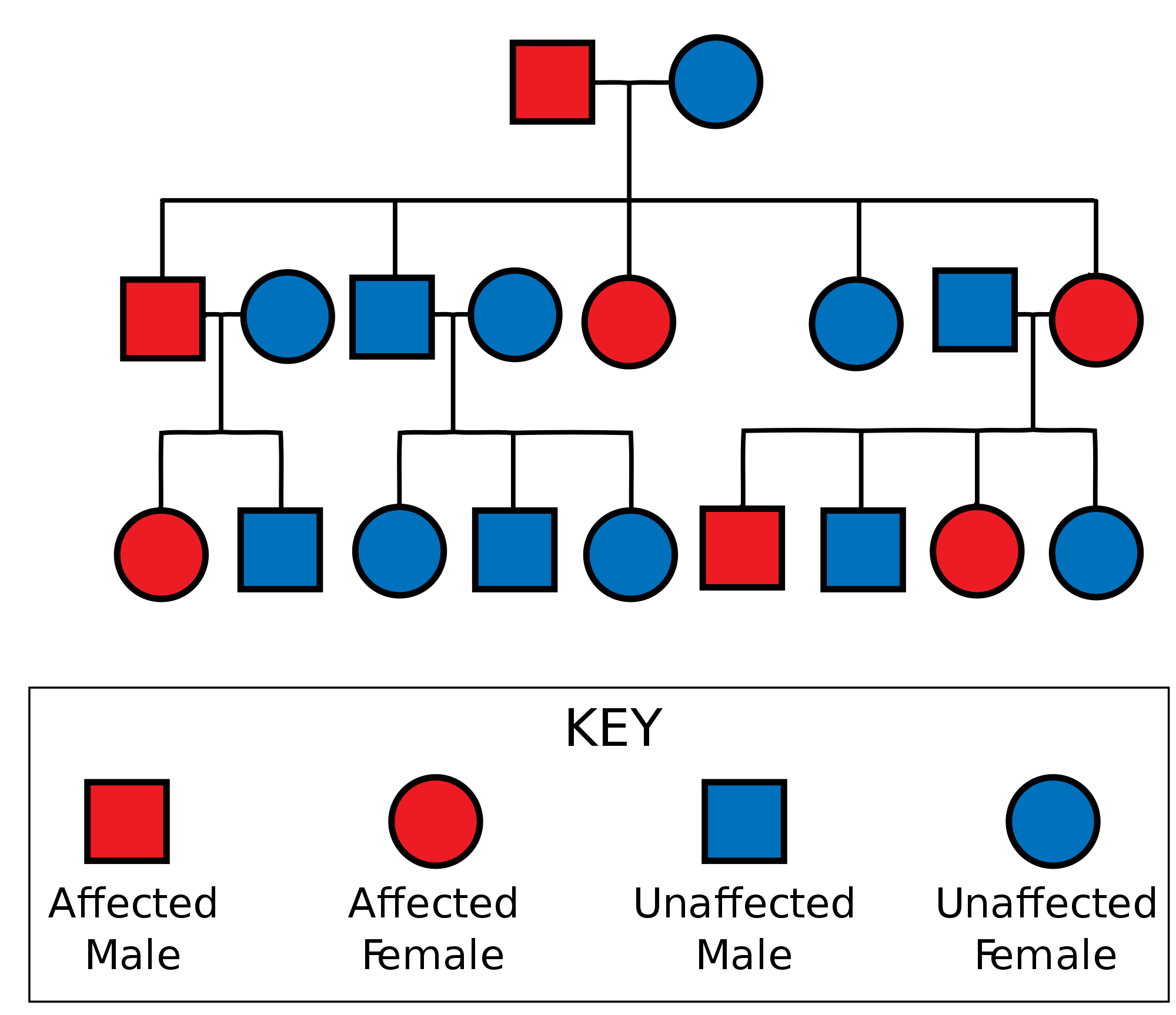
Punnett Square
A Punnett square is a chart that allows you to easily determine the expected ratios of possible genotypes in the offspring of two parents. You can see a hypothetical example in Figure 5.13.3. In this case, the gene is autosomal, and both parents are heterozygotes (Aa) for the gene. Half of the gametes produced by each parent will have the A allele, and half will have the a allele. That’s because the two alleles are on homologous chromosomes, which always separate and go to separate gametes during meiosis. The alleles in the gametes from each parent are written down the side and across the top of the Punnett square. Filling in the cells of the Punnett square gives the possible genotypes of their children. It also shows the most likely ratios of the genotypes, which in this case is 25 per cent AA, 50 per cent Aa, and 25 per cent aa.
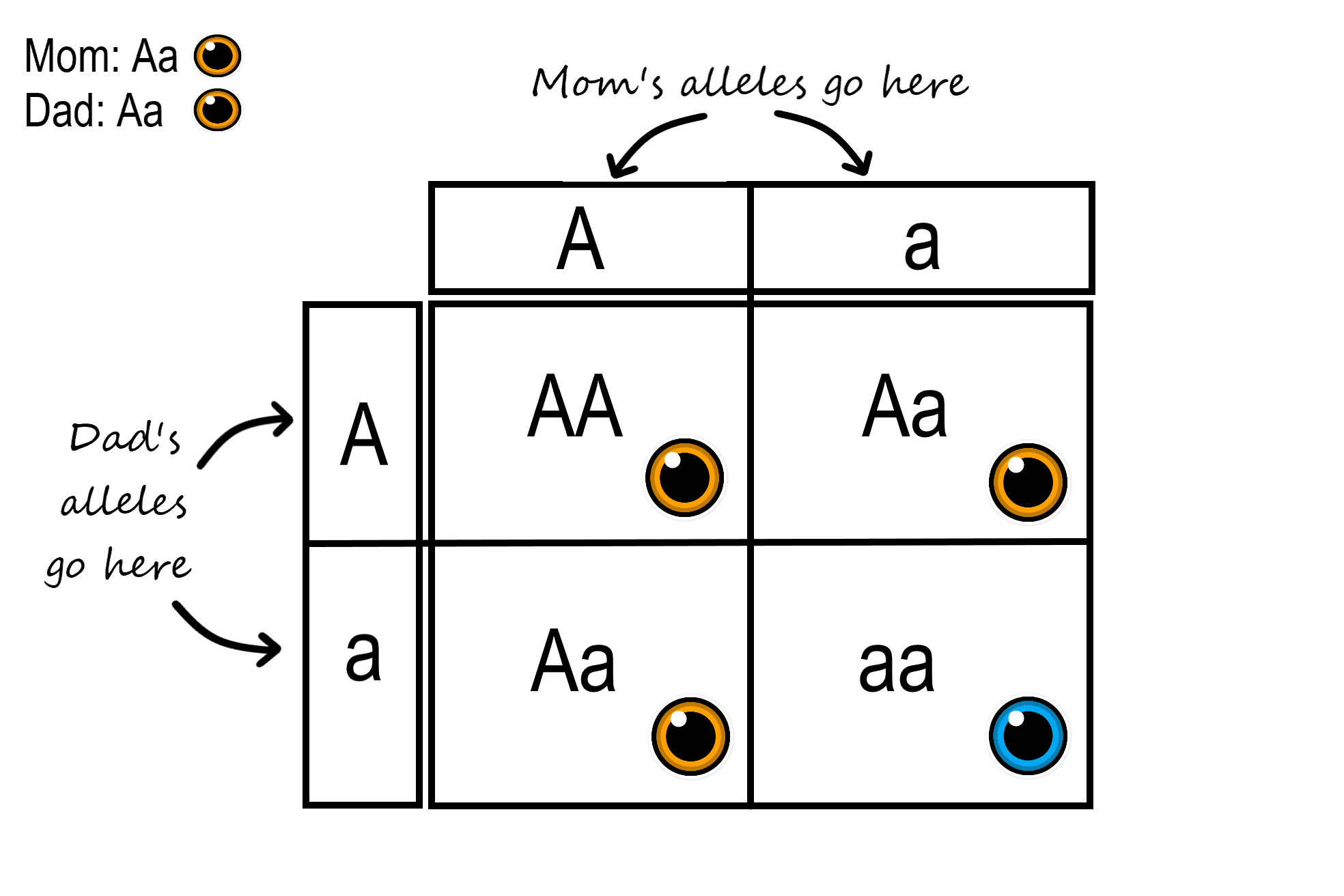
A Punnett square can also be used to show how the X and Y chromosomes are passed from parents to their children. This is illustrated in the Punnett square in Figure 5.13.4. It may help you understand the inheritance pattern of sex-linked traits.
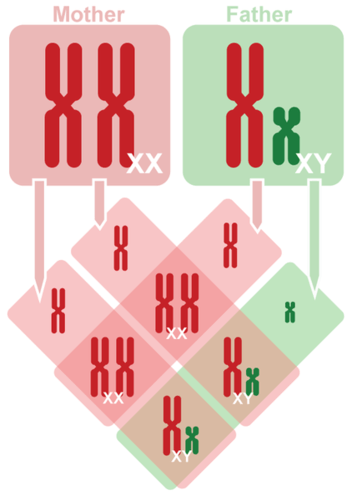
Here’s how to fill out a Punnett Square:
Learn Biology: How to Draw a Punnett Square, mahalodotcom, 2011.
Try out this Punnett Square:
Autosomal Mendelian Traits in Humans
Not many human autosomal traits are controlled by a single gene with two alleles, but they are a good starting point for understanding human heredity. As discussed in the beginning of this concept, most forms of albinism in humans have a Mendelian inheritance pattern. Albinism is usually controlled by a single autosomal gene with two alleles. The allele for normal pigmentation (let’s call it R) is dominant to the allele for albinism (r). Individuals with either an RR or Rr genotype will not have albinism, because the R allele is dominant over the recessive r allele.
However, consider what happens if two individuals with the Rr genotype reproduce with each other. The outcome would be similar to the example shown in the Punnett square above for two hypothetical Aa individuals. Their possible offspring could be RR (normal pigmentation), Rr (normal pigmentation), or rr (albinism). This explains why a child with albinism (rr), can have two parents that do not have albinism. Both unaffected parents must be a carrier of the recessive r allele, but they also have a dominant R allele that prevents them from having the condition themselves.
Some other human traits that have a Mendelian inheritance pattern are Huntington’s disease and wet versus dry ear wax. You may have heard about other human traits that were previously thought to be Mendelian, such as dimples, a widow’s peak hairline, hitchiker’s thumb, and the ability to roll your tongue. As science has progressed, it is now understood that these are not actually Mendelian traits. In fact, most human traits are actually controlled by multiple genes, or otherwise have more than two alleles, which means they do not have a simple Mendelian inheritance pattern.
X-Linked Mendelian Traits in Humans
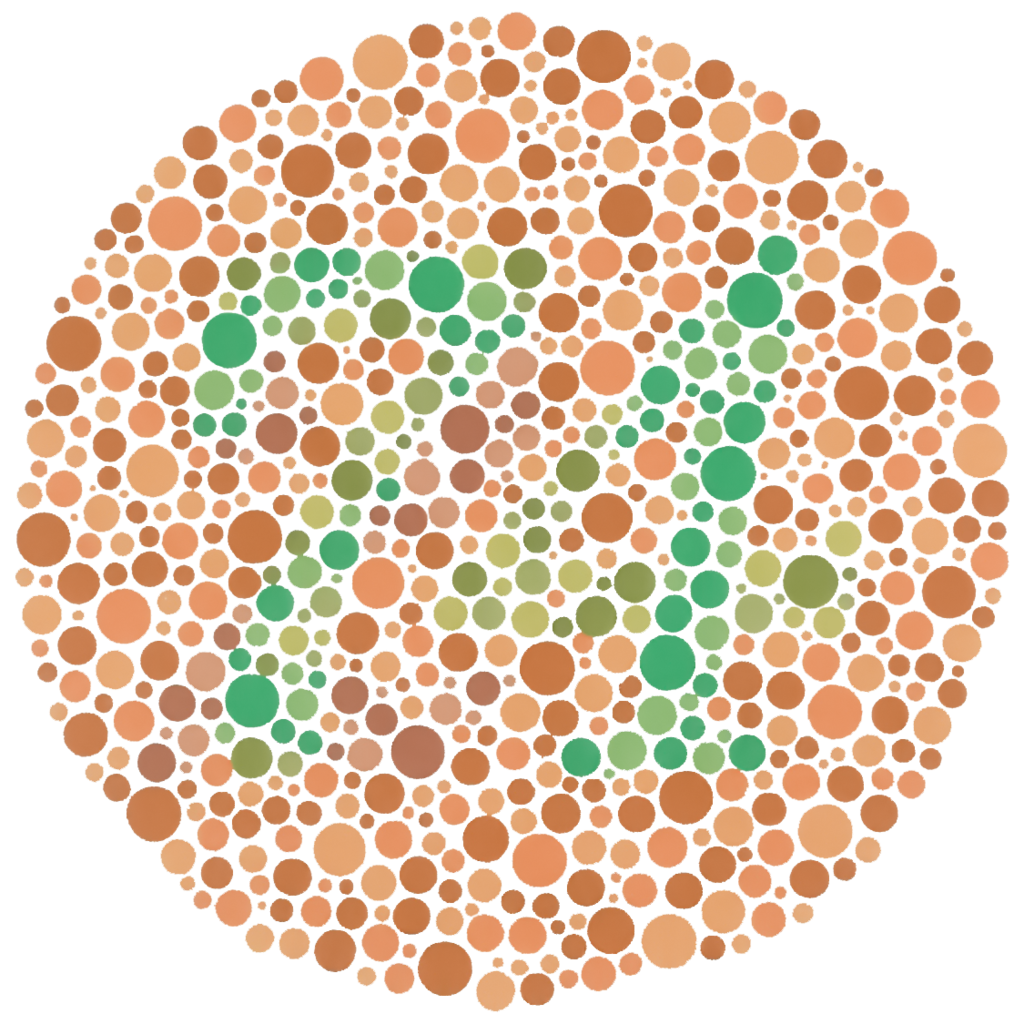
Because males have just one X chromosome, they have only one allele for any X-linked trait. Therefore, a recessive X-linked allele is always expressed in males. Because females have two X chromosomes, they have two alleles for any X-linked trait. Therefore, they must inherit two copies of the recessive allele to express an X-linked recessive trait. This explains why X-linked recessive traits are less common in females than males, and why they show a different pattern of inheritance than autosomal traits.
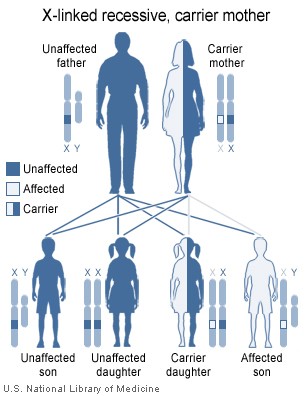
An example of a recessive X-linked trait is red-green colour blindness. People with this trait cannot distinguish between the colours red and green. More than one recessive gene on the X chromosome codes for this trait, which is fairly common in males, but relatively rare in females. Figure 5.13.6 shows a simple pedigree for this trait. A female with one of the recessive alleles for the trait does not have the trait herself, but can pass it on to her children. In this case, she is called a carrier of the trait. Half of any sons she has can be expected to have the trait, because there is a 50 per cent chance that they will inherit the X chromosome with the colour-blindness allele. Having only one X chromosome, the recessive allele will be expressed in the sons who inherit it. However, as long as the father is not affected, none of the woman’s daughters will have the trait. The daughters have a 50 per cent chance of inheriting the X chromosome with the colour-blindness allele, but it won’t be expressed because it is recessive to the normal allele they inherit from their father.
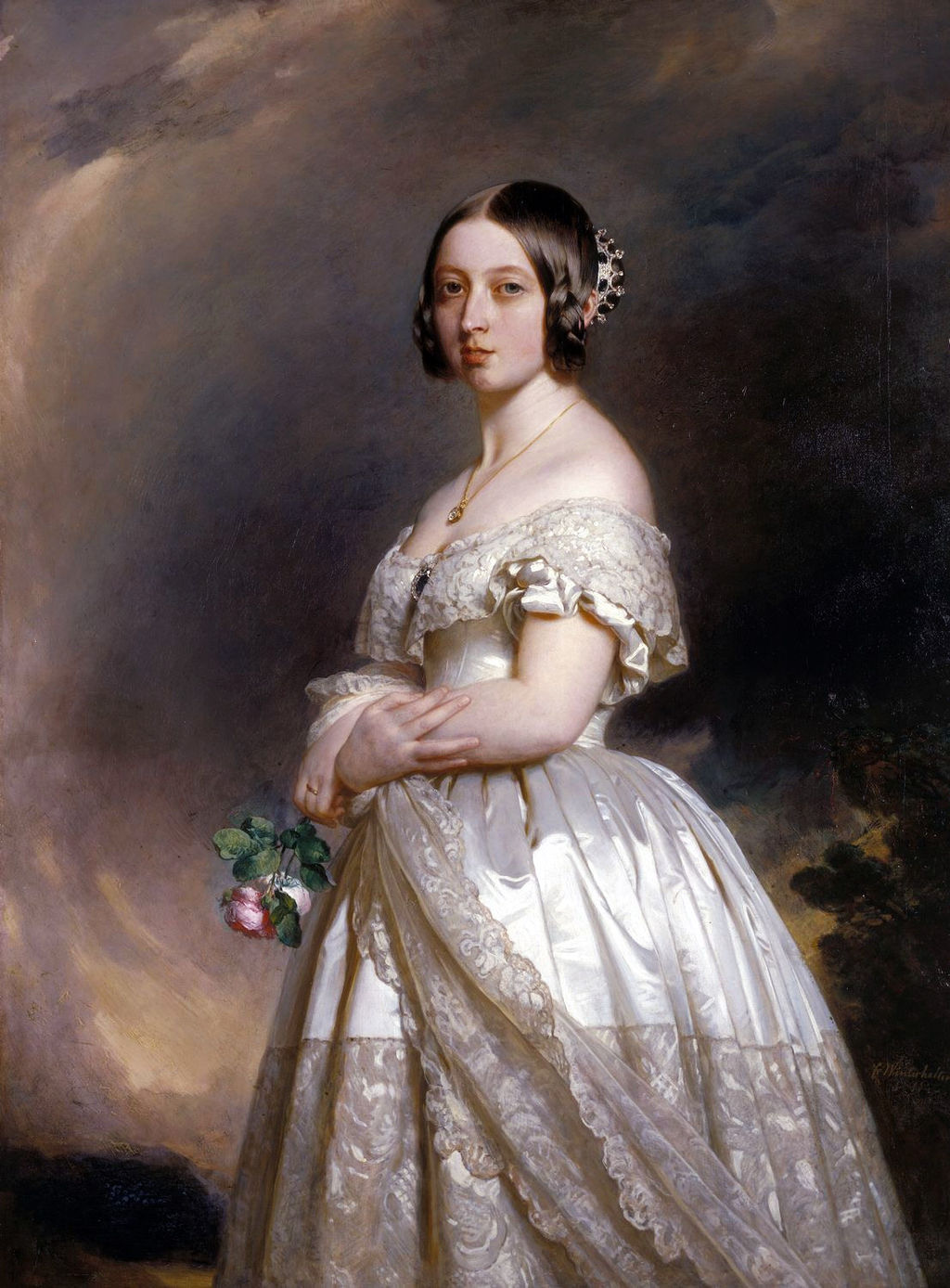
Another example of a recessive X-linked Mendelian trait is hemophilia, which is a disorder characterized by the blood’s inability to clot normally. England’s Queen Victoria (pictured in Figure 5.13.7) carried the disorder. Two of her five daughters inherited the hemophilia allele from their mother and were carriers. When they married royalty in other European countries, they spread the allele across Europe, including to the royal families of Spain, Germany, and Russia. Victoria’s son Prince Leopold also inherited the hemophilia allele from his mother, and he actually suffered from the disease. Understandably, hemophilia was once popularly called “the royal disease.”
Feature: My Human Body.
Are you colour blind, or do you think you might be? If you inherited this X-linked recessive disorder, a world without clear differences between certain colours seems normal to you. It’s all you have ever known! Some people who are colour blind are not even aware of it. Simple tests have been devised to determine whether a person is colour blind, and to what degree. An example of such a test is pictured in Figure 5.13.5. What do you see when you look at this circle? Can you clearly perceive the number 74? If so, you probably have normal red-green colour vision. If you cannot see the number, you may have red-green colour blindness.
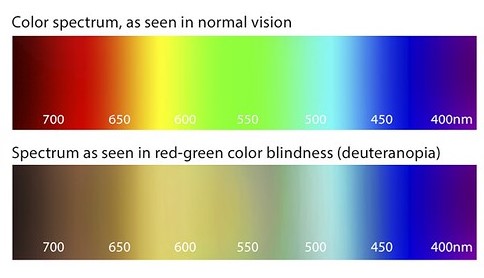
Being colour blind can cause a number of problems. These may range from minor frustrations to outright dangers. Here are a few examples:
- If you are colour blind, it may be difficult to colour-coordinate clothing and furnishings. You may end up wearing colour combinations that people with normal colour vision think are odd or clashing.
- Many LED indicator lights are red or green. Power strips and electronic devices, for example, may have indicator lights to show whether they are on (green) or off (red).
- Test strips for pH, hard water, swimming pool chemicals, and other common tests are also often colour coded. Litmus paper for testing pH, for example, turns red in the presence of an acid, but if you are colour blind, you may not be able to read the test result.
- Do you like your steak well done? If you are colour blind, you may not be able to tell if the meat is still undercooked (red) or grilled just right. You also may not be able to distinguish ripe (red) from unripe (green) fruits and vegetables, such as tomatoes. And some foods, such as dark green spinach, may look more like mud than food, making them totally unappetizing.
- Weather maps often are colour coded. Is that rain (green) in your forecast, or a wintry mix of sleet and freezing rain (pink or red)? If you can’t tell the difference, you may go out on the roads when you shouldn’t, putting yourself in danger.
- Being able to distinguish red from green traffic lights may be a matter of life or death. This can be very difficult for someone with red-green colour blindness. In some countries, people with this vision defect are not allowed to drive.
Figure 5.13.9 Examples of challenges faced by those who are colour blind
5.13 Summary
- Mendelian inheritance refers to the inheritance of traits controlled by a single gene with two alleles, one of which may be completely dominant to the other. The pattern of inheritance of Mendelian traits depends on whether the traits are controlled by genes on autosomes, or by genes on sex chromosomes.
- Two tools for studying inheritance are pedigrees and Punnett squares. A pedigree is a chart that shows how a trait is passed from generation to generation within a family. A Punnett square is a chart that shows the expected ratios of possible genotypes in the offspring of two parents.
- Examples of human autosomal Mendelian traits include albinism and Huntington’s disease. Examples of human X-linked traits include red-green colour blindness and hemophilia.
5.13 Review Questions
- Define genetic traits and Mendelian inheritance.
-
- Explain why autosomal and X-linked Mendelian traits have different patterns of inheritance.
- Identify examples of human autosomal and X-linked Mendelian traits.
- Imagine a hypothetical human gene that has two alleles,Qand q. Q is dominant to q and the inheritance of this gene is Mendelian. Answer the following questions about this gene.
- If a woman has the genotype Q q and her husband has the genotype QQ, list each of their possible gametes. What proportion of their gametes will have each allele?
- What are the likely proportions of their offspring beingQQ,Qq, or qq?
- Is this an autosomal trait or an X-linked trait? How do you know?
- What are the chances of their offspring exhibiting the dominant Q trait? Explain your answer.
- Explain why fathers always pass their X chromosome down to their daughters.
5.13 Explore More
Punnett Squares and Sex-Linked Traits, Amoeba Sisters, 2015.
Pedigrees, Amoeba Sisters, 2017.
Secrets of the X chromosome – Robin Ball, TED-Ed, 2017.
Attributions
Figure 5.13.1
Albino_baby_by_Felipe_Fernandes by Felipe Fernandes on Wikimedia Commons is used under a CC BY-SA 2.0 (https://creativecommons.org/licenses/by-sa/2.0) license.
Figure 5.13.2
Pedigree_Chart2.svg by Jerome Walker on Wikimedia Commons is used under a CC BY-SA 3.0 (http://creativecommons.org/licenses/by-sa/3.0/) license. (Derivative work of original image created by GAThrawn22)
Figure 5.13.3
Punnett square by Christine Miller is released into the public domain (https://en.wikipedia.org/wiki/Public_domain).
Figure 5.13.4
Inheritance of Sex Chromosomes by CK-12 Foundation is used under a CC BY-NC 3.0 (https://creativecommons.org/licenses/by-nc/3.0/) license.
 ©CK-12 Foundation Licensed under
©CK-12 Foundation Licensed under ![]() • Terms of Use • Attribution
• Terms of Use • Attribution
Figure 5.13.5
Red-Green Colour Blindness by Unknown author on Wikimedia is released into the public domain (https://en.wikipedia.org/wiki/Public_domain). (Original believed to be by Shinobu Ishihara)
Figure 5.13.6
XlinkRecessive by US National Institutes of Health on Wikimedia Commons is in the public domain (https://en.wikipedia.org/wiki/Public_domain).
Figure 5.13.7
The_Young_Queen_Victoria (painted portrait by Franz Xaver Winterhalter (photograph from the Osborne House, Isle of Wight) on Wikimedia Commoons is in the public domain (https://en.wikipedia.org/wiki/Public_domain).
Figure 5.13.8
Deuteranopia/ Figure 9.10 by Web Style Guide on Flickr is used under a CC BY-NC-SA 2.0 (https://creativecommons.org/licenses/by-nc-sa/2.0/) license.
Figure 5.13.9
- LED traffic light by Bidgee on Wikimedia is used under a CC BY 3.0 (https://creativecommons.org/licenses/by/3.0/deed.en) license.
- Universal indicator paper by Bordercolliez on Wikimedia is used under a CC0 1.0
Public Domain Dedication license (https://creativecommons.org/publicdomain/zero/1.0/deed.en) - Photo tags: Fruit tomatoes food fruits and vegetables fresh by InspiredImages on Pixabay is used under the Pixabay License (https://pixabay.com/service/license/).
- Simple Control with Indicator LIghts by Sam D. Wilbur on Wikimedia is used under a CC BY-SA 4.0 (https://creativecommons.org/licenses/by-sa/4.0/deed.en) license.
- Photo tags: Feet socks checkered striped pants colorful color by Suppenkasper on Pixabay is used under the Pixabay License (https://pixabay.com/service/license/).
References
Amoeba Sisters. (2015, January 23). Punnett squares and sex-linked traits. YouTube. https://www.youtube.com/watch?v=h2xufrHWG3E&feature=youtu.be
Amoeba Sisters. (2017, February 8). Pedigrees. YouTube. https://www.youtube.com/watch?v=Gd09V2AkZv4&feature=youtu.be
Brainard, J/ CK-12 Foundation. (2016). Figure 3 Inherited traits of sex chromosomes [digital image]. In CK-12 College Human Biology (Section 5.12) [online Flexbook]. CK12.org. https://www.ck12.org/book/ck-12-college-human-biology/section/5.12/
mahalodotcom. (2011, January 14). Learn biology: How to draw a punnett square. YouTube. https://www.youtube.com/watch?v=prkHKjfUmMs&feature=youtu.be
TED-Ed. (2017, April 18). Secrets of the X chromosome – Robin Ball. YouTube. https://www.youtube.com/watch?v=veB31XmUQm8&feature=youtu.be
Wikipedia contributors. (2020, June 26). Albinism in humans. In Wikipedia. https://en.wikipedia.org/w/index.php?title=Albinism_in_humans&oldid=964622728
Wikipedia contributors. (2020, June 29). Gregor Mendel. In Wikipedia. https://en.wikipedia.org/w/index.php?title=Gregor_Mendel&oldid=965090119
Wikipedia contributors. (2020, June 17). Ishihara test. In Wikipedia. https://en.wikipedia.org/w/index.php?title=Ishihara_test&oldid=963014774
A type of biological inheritance that follows the principles originally proposed by Gregor Mendel in 1865 and 1866, re-discovered in 1900 and popularised by William Bateson.
A variant form of a given gene, meaning it is one of two or more versions of a known mutation at the same place on a chromosome. It can also refer to different sequence variations for a several-hundred base-pair or more region of the genome that codes for a protein.
The phenomenon of one variant of a gene on a chromosome masking or overriding the effect of a different variant of the same gene on the other copy of the chromosome.
Any chromosome that is not a sex chromosome.
A pair of chromosomes that determines biological sex.
A trait in which a gene is located on a sex chromosome. This is because the X chromosome is large and contains many more genes than the smaller Y chromosome. In a sex-linked disease, it is usually males who are affected because they have a single copy of X chromosome that carries the mutation
A trait where a gene is located on the X chromosome.
A diagram that shows the occurrence and appearance of phenotypes of a particular gene or organism and its ancestors from one generation to the next, most commonly humans, show dogs, and race horses.
A square diagram that is used to predict the genotypes of a particular cross or breeding experiment. Named after Reginald C. Punnett, who devised the approach, this diagram is used by biologists to determine the probability of an offspring having a particular genotype.
A sequence of nucleotides in DNA or RNA that codes for a molecule that has a function.
The part of the genetic makeup of a cell, and therefore of any individual, which determines one of its characteristics (phenotype).

